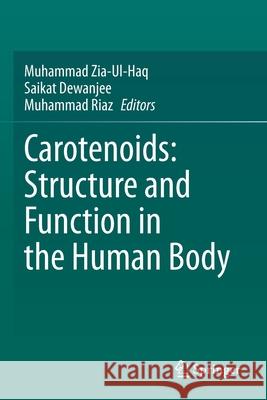Carotenoids: Structure and Function in the Human Body » książka



Carotenoids: Structure and Function in the Human Body
ISBN-13: 9783030464615 / Angielski / Miękka / 2022 / 876 str.
Carotenoids: Structure and Function in the Human Body
ISBN-13: 9783030464615 / Angielski / Miękka / 2022 / 876 str.
(netto: 766,76 VAT: 5%)
Najniższa cena z 30 dni: 771,08
ok. 22 dni roboczych.
Darmowa dostawa!
1. Introduction of Carotenoids
2. Chemistry of Carotenoids
3. Synthesis of Carotenoids
4. Apocarotenoids
5. Processing of carotenoids
6. Stability of carotenoids
7. Carotenoid analysis
8. Carotenoids Metabolism
9. Fortification of carotenoids
10. Carotenoids as antioxidants
11. Carotenoids as anticancer agents
12. Carotenoids as antidiabetic agents
13. Carotenoids in liver and lung diseases
14. Eye Sight and Carotenoids
15. Role of Carotenoids in Neurological Diseases16. Carotenoids in women and infant health
17. Carotenoids roe in cardiovascular diseases
18. Application of Carotenoids in Cosmetics19. Carotenoids as Coloring Agents
20. Provitamin A Carotenoids
21. Commercialization and marketing potential of carotenoids22. Future trends and research dimensions
Dr. Muhammad Zia-Ul-Haq, has a PhD from University of Karachi, Pakistan.He also has a LLB from Punjab University Pakistan and LLM-IP from Turin University Italy.Currently he is serving Office of Research, Innovation and Commercialization, Lahore College for Women University as Senior Manager. Previously he served as Patent Examiner in The Patent Office, IPO Pakistan (Ministry of Commerce) for 8 years. He received Patent trainings from Japan, Korea, Malaysia, USA and France. He has published 2 books with Springer, more than 120 research and review papers with total IF of 120 and total Google Scholar Citations of 4500.He is peer reviewer of many journals published by Elsevier and Springer. He won RPA from Pakistan Council for Science and Technology (PCST),Ministry of Science and Technology (MOST) from 2010-2015.
Dr. SaikatDewanjee, a pharmacist by qualification with specialization in Pharmacognosy, holds a post-graduate and a doctoral degree in Pharmacy from Jadavpur University, India. Dr. Dewanjee is an Associate Professor in the Department of Pharmaceutical Technology, Jadavpur University. He pursued his postdoctoral research at the University of Lisbon, Portugal through Fundação para a Ciência e a Tecnologia, Postdoctoral Research Fellowship. Dr. Dewanjee has been awarded the Endeavour Research Award, Government of Australia. His research is based on a trans-disciplinary perspective integrating the classical Pharmacognosy and modern biotechnology to develop natural product-based drugs or supplements. He is a principal investigator and collaborator in the Government of India-funded research projects involving bioactive products from natural sources. Dr. Dewanjee supervised more than 12 PhD students. His publication portfolio comprises 90+ peer-reviewed journal articles with an h index of 21 (Scopus) and 12+ book chapters. He has delivered scientific presentations including invited talks on different national and international platforms. Dr. Dewanjee is a recipient of several awards from different national and international organizations. Dr. Dewanjee serves as an Associate Editor of BMC Complementary Medicine and Therapies, an Academic Editor of PLoS One, and a Guest Associate Editor for the special issue of Frontiers in Pharmacology on “Inspired by Nature: Towards Novel Anti-infective Agents”. Dr. Dewanjee’s scholarly activities include service on scientific and review panels of federal agencies, professional boards, learned societies, and expert committees in Indian and abroad.
Dr. Riaz is currently an Assistant professor in Shaheed Benazir Bhutto University Sheringal, Pakistan. He completed PhD in Pharmacognosy from University of Karachi Pakistan followed by a post-doctoral fellowship in Prof. Dou Deqiang Lab, Liaoning University of Traditional Chinese Medicine China. During his PhD,he worked in Prof. Michael Heinrich Labs, UCL School of Pharmacy, London, on Extraction from medicinal plant Pouzolziaindica.He has manypeer reviewed publication in renowned journals at national&international level and authored a book on Anthocyanins in 2016 for Springer.Plants produce chemicals as part of their normal metabolic activities. These include primary metabolites found in all plants, such as sugars and fats, as well as secondary metabolites, which can have therapeutic effects in humans and be refined to produce drugs. Plants synthesize a bewildering variety of phytochemicals, but most are derivatives of a few biochemical motifs. Numerous herbal-derived substances have been evaluated for their therapeutic potential. These include alkaloids, coumarins, saponins, plant pigments and flavonoids. Flavonoids, carotenoids and anthocyanins are probably the best known of these substances due to their antioxidant properties.
Carotenoids: Structure and Function in the Human Body presents comprehensive coverage of carotenoids. The text covers the scientific literature and clinical significance of this organic pigment, with an emphasis on its therapeutic potential. The authors approach carotenoids from a range of perspectives, from their structural and physicochemical properties to their distribution in nature, interaction with the human metabolism, and use as a coloring agent in various products. The intake, metabolism and secretion of anthocyanins in the human body are covered in-depth, as are the biosynthetic pathways through which these compounds are synthesized in the natural system. Factors affecting stability and extraction are listed, and health-related uses and biological activities are covered in great detail. Present and future trends in carotenoid research are also presented. This book provides a solid background in carotenoids for researchers and professionals in food science, food technology, nutrition, biology, chemistry and medical sciences.
1997-2026 DolnySlask.com Agencja Internetowa
KrainaKsiazek.PL - Księgarnia Internetowa









